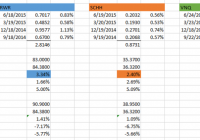Dividend ETFs: Another Canary In The Coal Mine?
Bloomberg reports that money is flowing out of dividend-focused ETFs. That’s a big change after years of inflows. Pair this up with the REIT and Utility selloff, and maybe dividend investors should start getting worried. Years ago, coal miners would bring canaries into the mines with them. Not because they wanted to have a mascot around, but because canaries were more sensitive to deadly gases. When the bird died, it was time for the humans to run for the exits. Right now, the shift taking place in income-oriented stocks could be flashing just such a warning sign. Who doesn’t love an ETF? According to Bloomberg , Vanguard Dividend Appreciation ETF (NYSEARCA: VIG ) has seen more money flow in its doors every year since it was created in 2006. Until this year, that is. Roughly $800 million has left the roughly $20 billion fund so far in 2015. And VIG isn’t alone. According to Bloomberg the dividend ETF category, with about $100 billion in assets, has seen roughly $2 billion in outflows this year. Now that’s not a huge amount of money percentage wise, but it’s a clear indication that the popularity of dividend ETFs is waning. And that’s a big deal. But what’s going on? For starters, as the Federal Reserve has talked about raising short-term interest rates, the market has already started the process. The rate on 10-year treasuries has inched up from 1.6% to 2.3% this year. VIG yields around 2.2%. Why take the risk of owning stocks if you can get the same yield from a treasury? And to add insult to injury, VIG is down roughly 2% so far this year while sibling Vanguard S&P 500 ETF (NYSEARCA: VOO ) is up about 2%. VOO yields around 2%, for comparison. So VIG is lagging the broader market and it doesn’t offer much of a yield advantage compared to the S&P 500 Index. Once again, why bother with VIG? Bigger picture But that’s not the whole picture. For example, real estate investment trusts have also fallen out of favor. Vanguard REIT Index ETF (NYSEARCA: VNQ ) is down around 4% so far this year and roughly 12% from its early year highs. And Vanguard Utilities ETF (NYSEARCA: VPU ) is down roughly 11% this year and nearly 15% from its early year highs. So dividend ETFs aren’t the only ones facing performance headwinds. Note that market watchers have commented on the asset outflows from these two funds this year, too. The take away is that sectors of the market that are associated with dividend investing aren’t the bright spots they once were. They are lagging and seeing investor outflows. And it’s worth noting that VNQ and VPU both have higher yields than the 10-year treasury. So investor flight is about more than just yield. The most likely reason for all of this bad news is investor sentiment. And that’s a potentially dangerous thing if it starts to snowball. At that point it could easily turn into an avalanche of selling. Remember Benjamin Graham’s Mr. Market isn’t sane, the prices he offers sometimes appear ridiculously high and ridiculously low. This is just another way of explaining the pendulum nature of the market, in which prices move back and forth from the extremes. Over long periods, the prices may make sense, but over short periods that’s not really the case. The next shoe to drop? There’s no way to tell, of course, what might cause what’s happening to dividend-focused investments to turn into an avalanche. However, there’s a pretty big issue coming to a head right now: the Fed and short-term rates. Some suggest that any rate hike will be small so it will have little impact on companies. And, thus, should lead to little change in stock prices. You could also argue that any hike will be driven by economic improvement, though I’d argue that the economy is hardly robust and stable right now. But these counter arguments miss the emotional impact, which is what drives stock prices over short periods of time. And it also ignores the multi-year run up in the prices of dividend-focused investments. For example, despite their recent pull backs, VIG, VNQ, and VPU are up still up roughly 70%, 55%, and 40%, respectively, over the past five years. That’s down from early year highs and you could easily argue that the declines so far this year for REITs and utilities have brought at least these two sectors back into buying territory. This thesis, however, ignores the usual market pendulum from extreme to extreme. Yes, the pendulum swings through rational, but that normally happens as it’s swinging to the other extreme. In other words, I don’t think now is the time to be aggressive. I think caution is still in order. And until the Fed actually starts raising rates, uncertainty will be your enemy. So I think the canaries are starting to choke. Perhaps it’s not time to exit the mines just yet, but I’d sure be making plans to do so if you own anything speculative. Disclosure: I/we have no positions in any stocks mentioned, and no plans to initiate any positions within the next 72 hours. (More…) I wrote this article myself, and it expresses my own opinions. I am not receiving compensation for it (other than from Seeking Alpha). I have no business relationship with any company whose stock is mentioned in this article.
